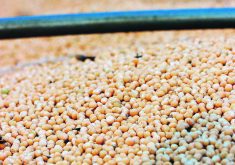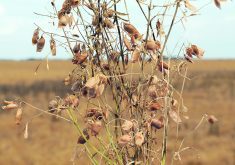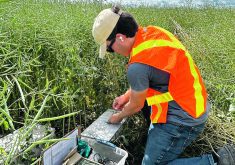Researcher is determined to do what it takes to make sure the crop remains a viable option for prairie farmers
This is part of an ongoing series of stories exploring rye, the crop, as it becomes Rye, the whisky.
Sometimes it takes a mad scientist to bring something new to life.
“My friends say I am obsessed with this crop improvement,” said Raja Ragupathy, an Agriculture Canada plant breeder in Lethbridge.
Other stories in this series:
- More producers start growing rye as crop prepares for a recovery
- Farmer finds new uses for old crop of rye
- Growing rye for seed is quirky but fun
- Rye’s agricultural journey set over thousands of years
- Hybrid varieties a game changer for rye sector
Read Also

Short rapeseed crop may put China in a bind
Industry thinks China’s rapeseed crop is way smaller than the official government estimate. The country’s canola imports will also be down, so there will be a lot of unmet demand.
“It’s so the producers get the new genetics. I will push these things. You don’t need a lot of funding.”
Ragupathy has a special place in his heart and within his breeding program for rye, a crop he believes has a great future and one he’s determined to keep in the western Canadian farmer’s toolbox.
“I love this crop,” said Ragupathy, a seasoned breeder born in India who has worked as a cereal breeder in Winnipeg, Saskatoon, Swift Current and Lethbridge.
“It’s so resilient.”
Rye breeding died in Canada for a while. The small acreage crop just didn’t justify breeder time or scarce funds and resources when other crops covered so many more acres and meant so much more to today’s farmers.
A great variety had been developed in 2006, AC Hazlet, by Grant Macleod, but that seemed to be the swan song for open-pollinated rye crop development in Canada. (That variety is still, almost two decades later, the dominant OP variety.)
People retired, programs lapsed and rye varieties available to farmers got older and older.
But in the last few years, Ragupathy has been trying to revive a small Canadian breeding program. He has been working with the varieties and materials in Canada while collaborating with European and other colleagues to identify great lines and genetics that might work in Canadian conditions.
Canadian production today is only about 200,000 acres, with about 86,000 acres in open-pollinated varieties and the rest in hybrids developed in Europe. Many of those hybrid acres have been saved for rye because of the excellent results they have been achieving, but Ragupathy thinks much more is possible for both open-pollinated and hybrid.
However, the native Canadian material needs to be improved, and the European materials need to be screened and developed for Western Canada’s intense climatic conditions, which range from brutal cold to drought to high heat to flooding. Varieties that work in Europe don’t necessarily work out in Canada.
He and other breeders have been screening, sorting and testing numerous lines and developing new ones that might make their way into farmers’ hands. However, any new variety has to beat that old standard that still holds the field.
“If you want to replace Hazlet, you need to have something unique or special compared to Hazlet,” said Ragupathy.
Developing new lines of OP rye isn’t easy. Unlike some crops whose pollen drifts only a few metres, rye pollen can drift hundreds of metres, creating plot location nightmares for a breeder.
“It is a challenge, but as a scientist I like challenges,” said Ragupathy.
The rye genome has been sequenced by German researchers, which is proving to be of great value for breeders trying to isolate valuable characteristics.
“It’s one more tool as a breeder.”
Ragupathy’s appreciation of rye comes from its toughness. It can survive frigid winters better than winter wheat, its root system can handle drought, and it makes it through most conditions better than most other crops.
With climate change threatening to make crop production more challenging, with rotations being compressed by overreliance on a couple of crops, and with biodiversity becoming a bigger and bigger concern, having rye in the prairie farmer’s rotation could bring multiple advantages, he said.
“You don’t need so many inputs. That’s the great thing. You can grow it anywhere. Some farmers grow it as a cover crop.”
So he’s committed to working with whatever resources he can scrounge up to keep rye breeding alive in Canada. Fortunately, Ag Canada encourages him to keep going.
“They always ask us to think big and have a bigger vision,” said Ragupathy.
“My role is to build this population, what we refer to as pre-breeding.”
Cereal-breeding colleagues at Ag Canada, universities and industry in Canada and Europe work collaboratively to advance this crop, which often gets overlooked.
Funding from SeCan and the Western Grains Research Foundation has also been a godsend.
“They funded me to keep the pipeline alive.”
The ability for farmers to keep growing rye comes from the continuing excellence of Hazlet and the new hybrids from Europe.
But Ragupathy doesn’t want to see farmers relying on aging varieties or completely foreign imports unmodified for Canada.
“It is always good to have a home-grown cultivar,” said Ragupathy.
It might be a few more years before there are new made-in-Canada rye varieties for farmers to try, but they are on the way.
Rye researchers might not have resources like the plant breeders of giant crops get, but a fanatical commitment to a vision can make up for a lot.
















